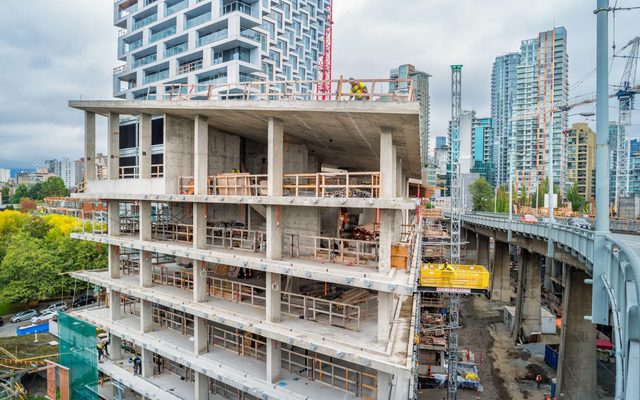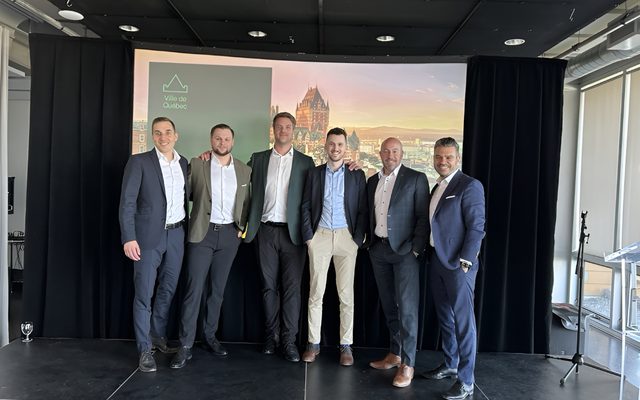Commercial real estate pros met in Québec City last week to discuss evolving dynamics in the office sector and the future of real estate in the province.
Participants at the Québec City Real Estate Forum noted the challenges and opportunities in the market. They also emphasized the importance of collaboration and adaptability in navigating a rapidly changing environment.
What to do about office
Against the backdrop of an 18% office vacancy rate across Québec, discussions about the future of the sector abounded.
Participants weighed the pros and cons of three primary strategies: selling, modernizing and converting office space. Transforming office properties to residential use was of particular interest, though some noted it could lead to a possible shortage of office space in the event of a full return to in-office work.
Vincent Chiara, president of Groupe Mach, stressed the need to address today’s reality versus a potential shortage of space down the road. “When we get there, we build again,” he said. “Right now, we need to be realistic that a return to office is not imminent and we have a housing crisis.”
Martin De Rico, president and partner at DeRico Experts-Conseils, noted the challenges in financing residential conversion projects. “Office is a weird bug these days,” he said, noting that there use to be much more competition among lenders to finance projects.
What’s more, the hybrid work model is likely here to stay.
“We surveyed 132 employers, and only 5.12% have a policy for a minimum number of days, with just 3% requiring three days or more,” said Claude Sirois, managing director and head of real assets and private equity at Industrial Alliance Investment Management.
“Over time, people will see the benefits of being in the office, for learning and advancement, but this will take three to five years before we see a return to office. This is part of a cycle – it will redevelop, but right now residential is taking precedence.”
Pros also pointed to the hurdle of municipal delays that projects face in Québec. Proposals must go through council review and a public consult. If there is any pushback, there must be a referendum.
Getting it right in retail
Québec’s retail sector has embraced mixed-use conversion and parcel sales as solutions to post-pandemic vacancies.
Dean Mendel, president at Groupe Forum, underscored the importance of essential-service anchor tenants in providing stability amid economic fluctuations. With the 10% population increase across the province, there is opportunity, and with the right anchors, the properties’ opportunity radius extends to the surrounding regions.
“We are seeing low vacancy rates and increasing rental rates,” he said. “With underserved pockets in Québec and Lévis, we are seeing less competition than other Canadian areas. All ingredients are there to grow strong. As in all markets, densification and mixed-use play a major role. Too much retail surrounding retail chokes the market.”
Francois Pelchat, associate vice president of development, leasing and marketing at Immostar, called retail “an interesting product that brings increased traffic to neighbourhoods.”
Industrial still stable
The industrial market continued to demonstrate stability in the third quarter.
Steven Bouffard, vice president of leasing at Pure Industrial, described the industrial asset class as the most even-keeled, despite the many dynamics at play.
“No asset has more variables than industrial,” he said. “The average size is 7,000 sq ft. The e-commerce and small-medium business ecosystem are pockets that are performing well. New developments are difficult to reproduce with the urban regulations of today.”
Peter McFarlane, head of real estate operations at Pure Industrial, emphasized the conversion of older structures to create optimal warehousing space, noting a 50-year trend of increasing industrial use due to the growth of e-commerce.
“The focus is on reinvesting in units and improving services such as waste collection and energy audits,” he said.
Regional developments and energy initiatives
Regions like Saguenay and Trois-Rivières are preparing to accommodate provincial population growth. By streamlining permit processes and expanding infrastructure budgets, these regions aim to attract developers.
Saguenay, for example, has allocated $72m for infrastructure enhancements and is known for its swift permit approval process, completing analyses in as little as 14 days.
In the energy and data center sector, Martin Bouchard, president and co-founder of QScale, highlighted the challenges posed by Hydro-Québec’s regulations.
He noted that in Québec, projects requiring 5 megawatts or more face major roadblocks. “Entrepreneurs can’t wait 10 years; it is too long and there is not enough transparency,” Bouchard said.
On the residential side, however, Hydro-Québec is incentivizing energy-efficient buildings by offering subsidies up to $500,000. La Bouée’s Albédo project, for instance, received $3,393 per door in subsidies.
The agency is considering implementing reverse incentivizes over the next decade, potentially imposing penalties on developments that fail to meet minimum requirements.
Native reservation initiatives
Projects within Native reservations, where traditional financing is becoming more accessible, were also a key topic.
One example is the Ya’ndiyatha’ partnership, a 1m sq ft development initiative between the Huronne-Wendat and Immostar. Francois Pelchat, partner and vice president of leasing and marketing at Immostar, announced the project, which he said is a response to the on-reservation housing crisis. It serves as a pilot to inspire future projects as it aims to harness expertise in collaboration with Native representatives, creating a distinctive space within the forest.
Pelchat remarked, “The local population are the ones who will decide on the zoning – promoters need to learn how to integrate.”
Maxime Picard, director of economic development at Nation Huronne-Wendat, highlighted the project’s sensitivity to building height. The Secteur Ononta’ project, also covering 1m sq ft, is a green space initiative surrounded by forestry.
“With 1,000 people on a waiting list to join the reserve, there is an urgent need to create an environment that prioritizes energy conservation and cultural preservation.”
Picard emphasized that the project would prioritize members of the community, while acknowledging interest from other nations seeking community space, with the goal of fostering a sense of familiarity and cultural unity.
Government subsidies are being sought to manage housing expenses, with groundbreaking scheduled for November. Completion is expected in the third or fourth quarter of 2025.
Article updated at 2:22 p.m. ET on Oct. 29, 2024, to reflect that Immostar is partnering with the Huronne-Wendat.




